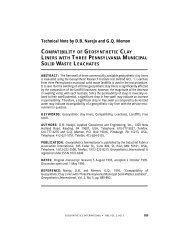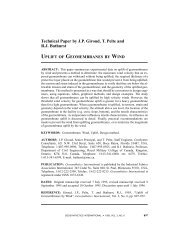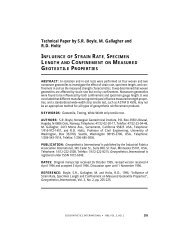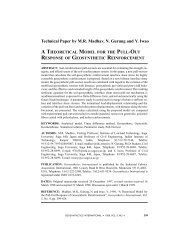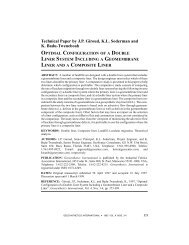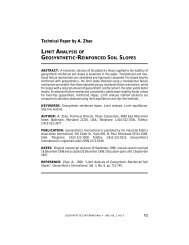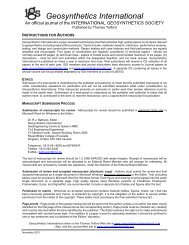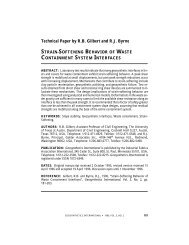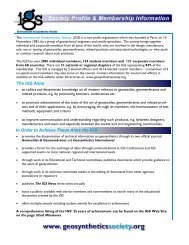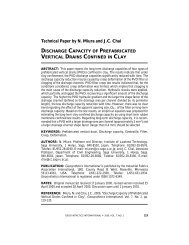Technical Paper by D.J. Elton and I. Peggs - IGS - International ...
Technical Paper by D.J. Elton and I. Peggs - IGS - International ...
Technical Paper by D.J. Elton and I. Peggs - IGS - International ...
You also want an ePaper? Increase the reach of your titles
YUMPU automatically turns print PDFs into web optimized ePapers that Google loves.
<strong>Technical</strong> <strong>Paper</strong> <strong>by</strong> D.J. <strong>Elton</strong> <strong>and</strong> I. <strong>Peggs</strong><br />
GEOMEMBRANE RESEARCH NEEDS<br />
ABSTRACT: A US National Science Foundation/Auburn University Workshop was<br />
held in Summer 2000 to identify geomembrane-related topics that require research.<br />
Three publications were produced: a geomembrane state-of-practice paper, a paper on<br />
research needs, <strong>and</strong> a final paper on organizing similar workshops. The present paper<br />
focuses on geomembrane research needs, with the intent of moving the profession forward<br />
<strong>by</strong> identifying what new knowledge/research is needed <strong>and</strong> how to get it. Stimulating<br />
discussion on the subject is a secondary purpose of the paper. Ten professionals,<br />
selected for their expertise <strong>and</strong> experience, attended the Workshop. Most facets of the<br />
geomembrane/waste disposal industry were represented. The participants almost exclusively<br />
represented United States geomembrane practice. Most of the discussions related<br />
to high-density polyethylene, linear low-density polyethylene, polyvinyl chloride, <strong>and</strong><br />
polypropylene geomembranes. The Workshop considered seventeen topics related to<br />
geomembranes in waste, water, <strong>and</strong> product containment systems. The topics were seam<br />
tests, seam strength, wrinkles, lifetime predictions, seams types, geomembranes on<br />
steep walls, thermal seams in PVC geomembranes, geomembranes in bioreactors, durability,<br />
remote leak repair, defect significance, shear displacements, seams in different<br />
geomembrane types, leak location <strong>and</strong> significance, puncture protection, <strong>and</strong> multiaxial<br />
testing.<br />
KEYWORDS: Geomembrane, Research, Liner, L<strong>and</strong>fill.<br />
AUTHORS: D.J. <strong>Elton</strong>, Associate Professor, Civil Engineering Department, Auburn<br />
University, Alabama, 36849, USA, Tel: 1/334-844-6285, Fax: 1/334-844-6290, E-<br />
mail: elton@eng.auburn.edu; <strong>and</strong> I. <strong>Peggs</strong>, President, I-Corp <strong>International</strong>, 6072 N.<br />
Ocean Blvd, Ocean Ridge, Florida 33435-5210, USA, Tel: 1/561-369-0795, Fax: 1/<br />
561-369-0895, E-mail: Geoicorp@aol.com.<br />
PUBLICATION: Geosynthetics <strong>International</strong> is published <strong>by</strong> the Industrial Fabrics<br />
Association <strong>International</strong>, 1801 County Road B West, Roseville, Minnesota 55113-<br />
4061, USA, Telephone: 1/612-222-2508, Telefax: 1/612-631-9334. Geosynthetics<br />
<strong>International</strong> is registered under ISSN 1072-6349.<br />
DATE: Original manuscript submitted 7 March 2002, revised version received <strong>and</strong><br />
accepted 12 November 2002. Discussion open until 1 May 2003.<br />
REFERENCE: <strong>Elton</strong>, D.J. <strong>and</strong> <strong>Peggs</strong>, I., 2002, “Geomembrane Research Needs”,<br />
Geosynthetics <strong>International</strong>, Vol. 9, No. 3, pp. 283-300.<br />
GEOSYNTHETICS INTERNATIONAL • 2002, VOL. 9, NO. 3 283
ELTON AND PEGGS • Geomembrane Research Needs<br />
1 INTRODUCTION<br />
A geomembrane research needs workshop was sponsored <strong>by</strong> the Civil <strong>and</strong> Mechanical<br />
Systems Division of the US National Science Foundation <strong>and</strong> Auburn University in<br />
the summer of 2000. Ten professionals met for two days <strong>and</strong> discussed 17 topics<br />
related to geomembrane research during moderated sessions. The discussion results<br />
were submitted to the US National Science Foundation.<br />
Not all possible topics were discussed, due to time limitations. Selection of the topics<br />
was made jointly <strong>by</strong> the participants <strong>and</strong> the organizers. An initial set of topics for<br />
discussion was proposed in a state-of-practice paper. Subsequently, topics were solicited<br />
from the participants together with their ranking of each topic’s significance. The<br />
organizers prioritized the responses in two different ways to arrive at the final topics.<br />
Although attendees were given the opportunity to modify the topic list at the opening<br />
of the Workshop, no changes were made.<br />
Not all attendees agreed with all the suggestions presented in this paper.<br />
2 ATTENDEES<br />
Ten professionals were invited, based on their expertise, experience, <strong>and</strong> availability.<br />
The intention was to have all facets of the geomembrane/waste disposal industry represented.<br />
The participants almost exclusively represented United States practice in the<br />
use of geomembranes.<br />
Most of the discussions related to high-density polyethylene (HDPE), polyvinyl<br />
chloride (PVC), <strong>and</strong> polypropylene (PP) geomembranes. These are the most commonly<br />
used geomembrane polymers <strong>and</strong> the ones the participants were most familiar with.<br />
3 RESEARCH TOPICS<br />
Seventeen geomembrane topics were discussed.<br />
1. Avoidance of destructive seam tests.<br />
2. Significance of strength in seam tests.<br />
3. Dealing with wrinkles.<br />
4. Lifetime predictions.<br />
5. Chemical versus thermal seams.<br />
6. Geomembranes on steep walls.<br />
7. Thermal seams in PVC geomembranes<br />
8. Geomembranes in bioreactors (also known as “active l<strong>and</strong>fill management”, or<br />
“wet cell operations”).<br />
9. Durability of textured geomembranes.<br />
10. Remote repair methods.<br />
11. Critical defect significance <strong>and</strong> determination.<br />
12. Shear displacements - laboratory versus field.<br />
284 GEOSYNTHETICS INTERNATIONAL • 2002, VOL. 9, NO. 3
ELTON AND PEGGS • Geomembrane Research Needs<br />
13. LLDPE-HDPE <strong>and</strong> white-black geomembrane welding.<br />
14. Electrical <strong>and</strong> other methods of leak location.<br />
15. Assessing puncture protection of geomembranes.<br />
16. Significance of leak location methods in light of low leak-rate findings.<br />
17. Multi-axial testing.<br />
Each topic is given below, followed <strong>by</strong> research needs <strong>and</strong> closing notes for the<br />
topic. The topics are not arranged in order, nor are the ideas for research listed under<br />
each topic.<br />
4 TOPICS DETAILS<br />
4.1 Topic 1: Avoiding Seam Destructive Tests<br />
The current state of practice for installing geomembrane l<strong>and</strong>fill liners includes a construction<br />
quality assurance (CQA) program. “Destructive seam testing” is the part of<br />
the construction quality assurance program where a sample of an installed geomembrane<br />
seam is cut out of the geomembrane <strong>and</strong> tested for mechanical properties. The<br />
resulting hole is then patched.<br />
Cutting <strong>and</strong> patching a hole in the geomembrane seam may lead to increased leakage<br />
in the liner, especially when the repair seaming method (often extrusion welding)<br />
is inferior to the original seaming method (often double-track hot wedge welding).<br />
Removing <strong>and</strong> patching may also reduce the strength of the seam or create a location<br />
for failure to initiate.<br />
It is desirable to avoid this procedure <strong>and</strong> replace it with a method(s) that does not<br />
damage the geomembrane yet provides at least the same assurance that the seam is satisfactory,<br />
both in impermeability <strong>and</strong> durability.<br />
Ideas for research in this area include:<br />
(a) Deliberately create defective double-track, hot-wedge welded seams <strong>and</strong> inflate the<br />
air channel to assess the effect of the defect. Then, measure the strength of the<br />
defective seams <strong>and</strong> determine the allowable strength based on these results.<br />
(b) Develop a correlation between non-destructive <strong>and</strong> destructive test results.<br />
(c) Develop a better non-destructive seam test. The test should measure the strength<br />
<strong>and</strong> integrity of the seam without removing a part of it. Types of non-destructive<br />
tests used in other fields should be investigated. Non-contact methods can be<br />
explored involving detection techniques from the aerospace industry.<br />
(d) Evaluate the effect of channel air pressure on the seam test results. Some countries<br />
use a higher pressure than the United States. There appears to be a need to st<strong>and</strong>ardize<br />
the pressure used. Investigate testing seam strength with air pressure, nondestructively.<br />
(e) Develop a statistical method for seam test-location selection. Some industries use<br />
statistical sampling, instead of relying on the CQA inspector. This may lead to<br />
more consistency in testing, but may provide an optimistic perspective of seam<br />
GEOSYNTHETICS INTERNATIONAL • 2002, VOL. 9, NO. 3 285
ELTON AND PEGGS • Geomembrane Research Needs<br />
quality.<br />
(f) Investigate the effect of air channel width in seam testing. Some machines produce<br />
different channel widths than others. “Squeeze-out” influences the channel width<br />
in all machines.<br />
(g) Seek to have objective seam strength data published. There are firms or professional<br />
organizations that have this data, but have not published it for widespread<br />
use. St<strong>and</strong>ardized reporting is needed.<br />
Closing Notes. The following are the several proposed changes in current procedures<br />
that bear investigation: use of a statistical method to decide where to do a destructive<br />
test; elimination of sampling at “every 150 m (500 foot)” interval from specifications;<br />
remove the requirement that thicker geomembranes must have a higher seam strength<br />
(reduce it to a design strength requirement); <strong>and</strong> reduce the number of destructive<br />
seam tests in double-track, hot-wedge welds (<strong>and</strong>/or test only at suspect locations).<br />
4.2 Topic 2: Significance of Strength in Seam Tests<br />
Currently, geomembrane seams are expected to have at least the same strength as the<br />
geomembrane. This may not be necessary for adequate design, as the geomembrane<br />
may have much more strength than is needed to function properly. For example, sometimes<br />
the geomembrane strength is chosen to assist with installation survivability or<br />
weldability. This strength may exceed that required for engineering stability.<br />
Strength testing of geomembrane seams may not be generating useful information<br />
on seam bond strength; rather it reflects the low cross-sectional area of the geomembrane<br />
tab compared to the relatively high bonded area. If the bond efficiency exceeds<br />
only approximately 15%, the geomembrane will break, in both shear <strong>and</strong> peel tests,<br />
before the seam bond is adequately challenged.<br />
Ideas for research in this area include:<br />
(a) Determining what bond (seam) strength is acceptable based on design criteria<br />
rather than the currently required 90% of the geomembrane strength to be in the<br />
seam. If the designer only needs a certain tensile strength, perhaps seams should<br />
only be tested to insure that strength.<br />
(b) Shear strength the geomembrane parallel to the seam may be more important than<br />
strength perpendicular to the seam.<br />
(c) Stress versus strain data for the geomembrane adjacent to the seam, which is the<br />
weakest part of the installed geomembrane system, is needed. Perhaps place a<br />
clamp on the seam <strong>and</strong> a clamp on the geomembrane <strong>and</strong> then pull apart.<br />
(d) How to make stress versus strain properties of a weld the same as parent sheet?<br />
(e) What is the minimum strain acceptable to determine a good or bad seam?<br />
(f) What parameters define a “good” seam? Are bond <strong>and</strong> peel strengths needed?<br />
Bond efficiency (seam strength versus material strength)? Shear elongation <strong>and</strong><br />
peel separation? Determine data needed to define a good seam: what is needed <strong>and</strong><br />
at what level (workmanship?).<br />
286 GEOSYNTHETICS INTERNATIONAL • 2002, VOL. 9, NO. 3
ELTON AND PEGGS • Geomembrane Research Needs<br />
Closing notes. Most leaks in the geomembrane are found away from the seams.<br />
Experience shows that in-service seam failures are uncommon. Electrical leak detection<br />
has shown that most geomembrane damage results from placement of the protective<br />
cover/drainage layer. More effort needs to be spent on leaks away from the seams.<br />
Construction quality can be improved with the publication of a “Manual of Installation<br />
Practice”.<br />
4.3 Topic 3: Dealing with Geomembrane Wrinkles<br />
Wrinkles occur in a geomembrane during installation due to changes in liner temperature<br />
<strong>and</strong> deployment of cover soil. The wrinkles may interfere with leachate h<strong>and</strong>ling,<br />
increase the infiltration beneath a geomembrane (lack of intimate contact between the<br />
geomembrane <strong>and</strong> clay beneath), decrease durability, <strong>and</strong> increase the chance of construction<br />
damage. While current specifications often require “no wrinkles”, a more<br />
measurable/enforceable description is needed, as well as a greater underst<strong>and</strong>ing of the<br />
effects of wrinkles on l<strong>and</strong>fill liner performance. Wrinkles occur on almost all<br />
geomembrane liner projects in North America. There is no clear guidance on what<br />
constitutes an acceptable amount of wrinkling for a given installation. There are often<br />
opposing goals in avoiding wrinkles <strong>and</strong> avoiding “bridging” or “trampolining”. On<br />
uncovered slopes, wrinkles will travel down slopes <strong>and</strong> cannot be redistributed up<br />
slopes.<br />
Current wrinkle reduction techniques include:<br />
• Coordinating installation <strong>and</strong> covering temperatures. For example, deploying the<br />
geomembrane during the warmer part of the day <strong>and</strong> covering during the cooler<br />
part of the day (especially night time).<br />
• Using light-colored pigments on the surface of the geomembrane instead of the traditional<br />
black.<br />
• Textured geomembranes <strong>and</strong> more flexible geomembranes tend to have less <strong>and</strong>/or<br />
lower amplitude wrinkles.<br />
Ideas for research in this area include:<br />
(a) How significant are wrinkles? A quantitative study is needed. The effects of size,<br />
direction, <strong>and</strong> distribution of wrinkles on performance need investigation. The<br />
answers will likely depend on the type of installation (e.g., l<strong>and</strong>fill liner, or cover,<br />
or pond liner) <strong>and</strong> the type of geomembrane used.<br />
(b) New construction procedures for “wrinkle-free” geomembrane installation need<br />
investigation. The Germans limit time of day of geomembrane installation <strong>and</strong><br />
slightly pretension geomembranes to eliminate wrinkles at the time of cover soil<br />
placement. The application of ballast tubes on slopes during installation may<br />
change the direction of wrinkles on the slopes.<br />
(c) An evaluation of the cost or risk versus the benefit of avoiding wrinkles needs to be<br />
performed. Obviously, the German model of the “wrinkle-free” installation would<br />
be technically desirable. The question of the economic benefit must be considered.<br />
To date, the geomembrane installation industry has de-facto presumed that the Ger-<br />
GEOSYNTHETICS INTERNATIONAL • 2002, VOL. 9, NO. 3 287
ELTON AND PEGGS • Geomembrane Research Needs<br />
man approach is not economically justifiable.<br />
Closing notes. More coordination between geomembrane installers <strong>and</strong> l<strong>and</strong>fill soil<br />
cover contractors is needed; a “Geomembrane Installation Manual of Practice” is<br />
needed so that CQA is better (recommendations in the manual need to be borne out <strong>by</strong><br />
research). The Manual would provide much needed guidance for l<strong>and</strong>fill construction<br />
practices to determine what level of wrinkling might be acceptable for different types<br />
of projects that use different types of geomembranes <strong>and</strong> would provide suggested<br />
construction techniques that could be used to realistically achieve those goals.<br />
4.4 Topic 4: Lifetime Predictions<br />
Geomembrane lifetime predictions are needed. The tools for making predictions of the<br />
life of polymers are better than ever. The current oxidative induction test (OIT) may<br />
not be a very good indicator of lifetime. The water vapor transmission (WVT) test may<br />
not define resistance to chemical breakdown of geomembranes. Damaging flaws <strong>and</strong><br />
defects need to be identified, <strong>and</strong> their critical sizes in different applications defined.<br />
Ideas for research in this area include:<br />
(a) A definition of “lifetime” is needed. Is this a change in a material property or performance?<br />
For example, some solvents may weaken a geomembrane, but never<br />
cause a breach.<br />
(b) The OIT alone is not a good indicator of durability. A better interpretation of the<br />
results of this test is needed vis a vis lifetime prediction. Moreover, currently, there<br />
is a wide variation of OIT results between laboratories.<br />
(c) The results of OIT on geomembranes with the new (2000) anti-oxidants need interpretation.<br />
Some antioxidants may not give high OIT values but may provide good<br />
service.<br />
(d) An examination of OIT versus xenon-arc tests is needed, to determine the applicability<br />
of each, <strong>and</strong> how to compare the results of each. OIT evaluates resistance to<br />
oxidation; xenon arc evaluates resistance to oxidation, ultraviolet radiation, <strong>and</strong><br />
moisture.<br />
(e) Perform an investigation to determine if there is a relation between WVT <strong>and</strong><br />
chemical resistance characteristics of a geomembrane.<br />
(f) Investigation of the durability of new plasticizers is needed. Perhaps newer ones<br />
can also provide greater geomembrane lifetimes.<br />
(g) Evaluate how OIT changes in surface layers <strong>and</strong> through the body of the material<br />
influence material mechanical durability.<br />
Closing notes. None of the current geomembranes fail the ASTM D5747 chemical<br />
resistance test; a paper on the lifetime predictions for HDPE <strong>and</strong> PVC is needed; an<br />
OIT state-of-the-art paper is needed.<br />
288 GEOSYNTHETICS INTERNATIONAL • 2002, VOL. 9, NO. 3
ELTON AND PEGGS • Geomembrane Research Needs<br />
4.5 Topics 5: Chemical versus Thermal Seams<br />
There are two major types of geomembrane seams – chemical <strong>and</strong> thermal seams.<br />
Both can provide adequate assurance against leaks. Selection is often based on the<br />
geomembrane material. Thermal seams include hot air welding, extrusion of melted<br />
polymer, <strong>and</strong> single-track <strong>and</strong> dual-track wedge welding. The advantages <strong>and</strong> applicability<br />
of chemical <strong>and</strong> thermal seams need further investigation. Peel-test criteria are<br />
different for chemical <strong>and</strong> thermal seams – perhaps this is unreasonable.<br />
Ideas for research in this area include:<br />
(a) Are chemical seams as good as thermal seams (or is one significantly better than<br />
the other)? It is harder to perform construction quality control/construction quality<br />
assurance (CQC/CQA) on chemical seams. An investigation of the quality of each<br />
installed seam type is needed.<br />
(b) What acceptance criteria should be adopted for each type of seam? Should they be<br />
the same? Is the peel test appropriate for each? Should a different interpretation of<br />
the peel test be applied to each?<br />
(c) Improved thermal welding for PVC geomembranes is needed. Current methods<br />
may cause loss of plasticizer. The use of dual-track welders, which allow air channel<br />
pressurization to check for leaks, is desirable. However, the heat from them<br />
may compromise long-term performance. More investigation of procedures for use<br />
of “mini-wedge” welders on PVC is needed. Minimum PVC geomembrane thickness<br />
for thermal welding is needed.<br />
(d) Are there better ways of making chemical seams?<br />
4.6 Topic 6: Geomembranes on Steep Walls<br />
Ab<strong>and</strong>oned quarries with steep, even vertical walls are beginning to be used for l<strong>and</strong>fills.<br />
This provides new design challenges. Quarry walls are often rugged <strong>and</strong> have texture<br />
sizes ranging from gravels to boulders. Therefore, the concept of cushioning needs<br />
to be a bit larger to encompass the need to create an acceptably smooth surface <strong>by</strong> filling<br />
voids that might not cause puncture, but lead to membrane bursting. The designer<br />
will have to deal with macroscopic undulations in addition to the smaller, localized<br />
protrusions that may cause puncture. Hence, protection here includes micro- <strong>and</strong><br />
macro-puncture <strong>and</strong> reinforced veneer facings.<br />
These large open areas present special problems, particularly with lining <strong>and</strong> drainage<br />
systems. The installation of geomembranes on the steep slopes requires research.<br />
Such facilities are being developed in Southeast Asia, California, Virginia, the United<br />
Kingdom, <strong>and</strong> elsewhere. Lining systems <strong>and</strong> their installation require research.<br />
Ideas for research in this area include:<br />
(a) What protection can be used to keep the geomembrane from being punctured <strong>by</strong><br />
the sides? Can protective layers be hung from the top of the wall? Perhaps geofoam,<br />
spray-on impervious or pervious cushions, tires or tire chips, or spray-on<br />
geomembranes can be used.<br />
(b) There are problems monitoring deep quarry sites for leakage. The extreme depth,<br />
GEOSYNTHETICS INTERNATIONAL • 2002, VOL. 9, NO. 3 289
ELTON AND PEGGS • Geomembrane Research Needs<br />
<strong>and</strong> occasionally depth below the water table, present special design challenges.<br />
New monitoring techniques are needed that allow adequate access to the quarry<br />
floor for monitoring. Perhaps a new class of remote leakage sensors is needed.<br />
(c) The stresses on geomembranes in the direction of the seam (not perpendicular)<br />
may be much greater than for conventional installations. Research on the longitudinal<br />
strength of seams is needed.<br />
(d) Need for double liner systems on vertical walls needs investigation. They may not<br />
be necessary.<br />
(e) Downdrag on lining systems needs investigation. Large waste settlements are<br />
expected. The effects of these settlements on the lining systems may be disastrous.<br />
New ways of reducing downdrag (slippery coatings, delaminating geomembranes)<br />
need to be developed <strong>and</strong> evaluated. Stronger geomembrane anchorages may have<br />
to be developed.<br />
Closing note. Quarry (or similar) lining is a small, but an increasing part of the<br />
geomembrane industry.<br />
4.7 Topic 7: Thermal Seams in PVC Geomembranes<br />
Thermal seaming of PVC geomembranes is becoming more popular. The effect of<br />
using heat on the long-term properties of PVC geomembranes is not well known. The<br />
effect of thickness on heat-related changes is not known. While it is known that heat<br />
drives off plasticizers, the effects of reduced plasticizers on seams are not well known.<br />
Ideas for research in this area include:<br />
(a) The effect of heat on PVC geomembranes in <strong>and</strong> immediately adjacent to seams.<br />
PVC geomembranes use plasticizers more than other polymeric membranes. The<br />
heat used for seaming may drive off the plasticizer, changing the quality of the<br />
seams. This is becoming more of a concern because new plasticizers are not subjected<br />
to as thorough testing as older plasticizers.<br />
(b) The development of plasticizers that are more heat resistant is needed to improve<br />
thermal welding.<br />
4.8 Topic 8: Geomembranes in Bioreactor L<strong>and</strong>fills (also known as “Active<br />
L<strong>and</strong>fill Management” or “Wet Cell Operation”)<br />
The use of l<strong>and</strong>fills as bioreactors is gaining momentum. In a bioreactor, liquids are<br />
added to the waste to expedite decomposition. The expedited decomposition increases<br />
the l<strong>and</strong>fill gas production, l<strong>and</strong>fill temperatures, <strong>and</strong> rate of waste settlement. L<strong>and</strong>fill<br />
temperatures as high as 80°C have been measured. The elevated service temperatures<br />
could impact the performance of the geomembrane.<br />
Ideas for research in this area include:<br />
(a) High concentrations of l<strong>and</strong>fill gas can show up between double liners. Research is<br />
required to determine if diffusion (rather than leakage) through geomembranes can<br />
create this problem.<br />
290 GEOSYNTHETICS INTERNATIONAL • 2002, VOL. 9, NO. 3
ELTON AND PEGGS • Geomembrane Research Needs<br />
(b) Bioreactors have high temperatures. Temperature monitoring of geomembranes<br />
<strong>and</strong> subgrades in bioreactor l<strong>and</strong>fills is needed.<br />
(c) Increased temperature effects on geomembranes bear investigation, as well as the<br />
effect of cooling when bioreaction is done. What geomembrane properties change<br />
<strong>and</strong> how could they impact the performance of the liner system? Thermal expansion,<br />
stress cracking resistance, puncture resistance, strain related creep, oxidation<br />
resistance, <strong>and</strong> stress relaxation may change significantly with heating <strong>and</strong> cooling.<br />
(d) The effect of large temperature <strong>and</strong> large thermal gradient up the sides of the l<strong>and</strong>fill<br />
as hot gases escape needs investigation. Large thermal gradients may cause, for<br />
example, large differential expansion of the lining systems.<br />
4.9 Topic 9: Durability of Textured Geomembranes<br />
Textured geomembranes are used to improve l<strong>and</strong>fill stability <strong>and</strong> stability of liner systems.<br />
Stability issues include interim filling of cells (short-term stability) or final l<strong>and</strong>fill<br />
configurations of canyon fills (long-term stability). The short-term durability of<br />
textured geomembranes, due to construction stresses, has been investigated. However,<br />
the long-term performance of frictional properties of the geomembrane has not been<br />
investigated. Chemical degradation, strain-related creep, or elevated temperature are<br />
potential factors to consider.<br />
Ideas for research in this area include:<br />
(a) Evaluation of the frictional properties of the delivered material is needed. Asperity<br />
height provides a qualitative evaluation, but doesn’t confirm design assumptions. A<br />
quick conformance friction test in the field that includes an ability to assess temperature<br />
effects is needed. German practice may be a good starting point for this<br />
research.<br />
(b) Unavoidable field abuse of geomembranes during construction may damage texture.<br />
A test/procedure that simulates field abuse would be useful. Texture evaluation<br />
research at Georgia Tech University (Atlanta, Georgia, USA) may be a good<br />
starting point for developing a field evaluation. Data from existing applications are<br />
needed, as well as experimental evaluations.<br />
(c) If sprayed-on texture is removed (delaminates), does it leave depressions/defects<br />
on the geomembrane that may lead to leakage due to changes in the geomembrane<br />
makeup or decreased thickness?<br />
(d) Does the angular nature of texture cause stress concentrations, leading to cracks or<br />
reduced durability? Does the bonding method for spray-on texturing affect stress<br />
cracking resistance?<br />
(e) Long-term creep tests on textured sheet are needed. This may help designers underst<strong>and</strong><br />
if there will be a reduction in the friction properties of textured sheet. The<br />
effect of resin type on texture durability is needed.<br />
(f) A comprehensive evaluation of friction change with exposure to various chemicals<br />
is needed.<br />
GEOSYNTHETICS INTERNATIONAL • 2002, VOL. 9, NO. 3 291
ELTON AND PEGGS • Geomembrane Research Needs<br />
4.10 Topic 10: Remote Repair Methods<br />
When flaws are found in seams, <strong>and</strong> leaks are found in lining systems, they must be<br />
repaired. At present, except for the concept of a geosynthetic clay liner, this requires<br />
exposing the liner, cleaning it, <strong>and</strong> making repairs using conventional installation<br />
technology.<br />
Repairs on seams <strong>and</strong> on the liner during construction can be made relatively easily.<br />
However, when the liner has been covered, especially with a significant depth of waste,<br />
repairing is very difficult. Failure to repair may result in premature l<strong>and</strong>fill closure.<br />
Electrofusion technology has been promoted, which is claimed to be effective<br />
underwater, but has proven to be marginally effective. After a hiatus of a number of<br />
years, electrofusion technology is now being reinvestigated <strong>and</strong> further developed. In<br />
Japan, precise drilling <strong>and</strong> injection grouting has been attempted to repair leaks,<br />
although this approach offers the potential for further damaging the liner. The emphasis<br />
must be to develop remote repair methods. Problems would include locating the<br />
leak, developing a material that would seal the leak in adverse conditions (heat, pressure,<br />
chemical, <strong>and</strong> moisture), being cost-effective, <strong>and</strong> providing proof that the repair<br />
was effective.<br />
Ideas for research in this area include:<br />
(a) Use a bentonite plug, grout, or polyurea to repair the hole in the geomembrane. A<br />
tool could be inserted through the waste near the liner leak <strong>and</strong> the material<br />
injected. Problems would include locating the leak, applying the correct amount of<br />
a material that would make the seal in adverse conditions, <strong>and</strong> finding a plug material<br />
that would not degenerate.<br />
(b) Develop a method using the electrophoresis of clay to locate <strong>and</strong> plug the hole in<br />
the liner. This method uses electricity. The method would have to overcome electrical<br />
conductivity of some waste components <strong>and</strong> the chemical make-up of the<br />
leachate. Laboratory studies indicate this process has potential.<br />
(c) Develop a clotting agent suspension, which could be applied before the geomembrane<br />
is covered, or injected into the waste later. Perhaps the suspension would<br />
begin to leak through the geomembrane when a hole develops, <strong>and</strong> clot in the hole<br />
as movement progresses, similar to the way human blood clots.<br />
(d) Develop chemicals that react with HDPE <strong>and</strong> PVC. The chemical would have to<br />
leave the geomembrane intact. The geomembrane polymer could act as a catalyst<br />
for the reaction while not using large amounts of geomembrane material sufficient<br />
to threaten geomembrane integrity.<br />
(e) Develop a technique of underwater (under-leachate) thermal welding. These methods<br />
could be used in conjunction with excavation of the waste, but not the leachate<br />
when a leak is located. New polymers <strong>and</strong> equipment may have to be developed.<br />
(f) Use of micromachines or nanobots to both locate <strong>and</strong> repair the leak. The robots<br />
could be embedded in the geomembrane during manufacture, added during installation,<br />
or introduced after installation. Robot sensors could detect leaks <strong>by</strong> thermal<br />
or hydraulic gradients <strong>and</strong> move to the leak. The robots could do welding (or other<br />
repair), or be made of a material that was sacrificial <strong>and</strong> form the plug themselves.<br />
292 GEOSYNTHETICS INTERNATIONAL • 2002, VOL. 9, NO. 3
ELTON AND PEGGS • Geomembrane Research Needs<br />
(g) Develop a five-layer coextruded geomembrane in which the second <strong>and</strong> fourth layers<br />
interact <strong>and</strong> swell to seal a hole when water/leachate penetrates a hole.<br />
Closing note. Some European l<strong>and</strong>fills have an inspection gallery under parts of the<br />
liner system, allowing visual geomembrane leak inspection <strong>by</strong> humans.<br />
4.11 Topic 11: Critical Defect Significance <strong>and</strong> Determination<br />
Often the problem when making repairs to geomembranes is to determine at what<br />
point a defect requires repair. For example, when is it necessary to fix a scratch <strong>and</strong><br />
when is acceptable to not fix it? Such knowledge would be very beneficial in terms of<br />
cost <strong>and</strong> time relating to making repairs on these defects. Critical defect characterization<br />
needs to be determined to assess geomembrane lifetime. Critical defect characterization<br />
will assist the CQA team in identifying defects that need attention.<br />
Locations in l<strong>and</strong>fills <strong>and</strong> ponds where geomembrane defects are most likely to<br />
have a detrimental effect should be identified - for example sumps <strong>and</strong> the corners of<br />
big ponds are more critical than central areas. Ponds may be more critical than l<strong>and</strong>fills,<br />
since the liquid pressure is higher, <strong>and</strong> more evenly distributed, <strong>and</strong> the pressure<br />
does not decrease when the liner settles. Pond liners are often exposed making them<br />
more susceptible to contraction stresses.<br />
Ideas for research in this area include:<br />
(a) Develop a classification method for scratches <strong>and</strong> notch defects including the following<br />
parameters: shape, length, width, depth, <strong>and</strong> location of the flaw. Fuzzy<br />
logic developed in conjunction with expert opinion may be very useful. The significance<br />
of the defect may depend on the waste type.<br />
(b) Develop a method, using the above classification, which indicates when to fix a<br />
defect <strong>and</strong> when to leave it alone. In addition, determine how many <strong>and</strong> what kind<br />
of scratches are cause for rejection of a geomembrane panel. Fuzzy logic is a likely<br />
source for development of this method.<br />
(c) More research on the effects of scratches on different polymers, including generation<br />
of stress cracking in HDPE is needed. Crack initiation <strong>and</strong> propagation kinetics<br />
information is needed. Some stress cracking may be mitigated <strong>by</strong> choice of<br />
polymer.<br />
(d) Develop design methods (<strong>and</strong> procedures) that avoid creating situations that lead to<br />
defects in installation. A “construction-friendly” design is needed.<br />
(e) Develop new effective ways to fix defects <strong>and</strong> flaws <strong>and</strong> evaluate the fix. For<br />
example, extruding a bead, fusing, or grinding out the defect without damaging the<br />
geomembrane or creating additional stress concentrating features. Perhaps the<br />
addition of a different polymer to the notch is needed.<br />
(f) Develop new methods to locate defects <strong>and</strong> flaws in a geomembrane (e.g., spreading<br />
a coating on the geomembrane, or using a colored dye for detection). There<br />
may be invisible light optical methods from the aerospace industry that can be<br />
transported to this industry.<br />
(g) Determine the effects of tear initiation, <strong>and</strong> defects like bubbles, dust, <strong>and</strong> s<strong>and</strong> in<br />
GEOSYNTHETICS INTERNATIONAL • 2002, VOL. 9, NO. 3 293
ELTON AND PEGGS • Geomembrane Research Needs<br />
the geomembrane, particularly in a seam. The effects of the shape, length, diameter,<br />
depth of these defects, <strong>and</strong> their proximity to other defects bears investigation.<br />
(h) Determine how fast stress relaxation in geomembranes takes place. This abates<br />
stress cracking in geomembranes <strong>and</strong> may alleviate the need to fix many flaws,<br />
speeding installations <strong>and</strong> reducing costs.<br />
(i) Identify locations in liners <strong>and</strong> covers where geomembrane defects are most likely<br />
to develop into detrimental defects. This may lead to proactive specifications,<br />
resulting in fewer defects.<br />
4.12 Topic 12: Shear Displacements - Laboratory Testing versus Field<br />
Experience<br />
For large direct shear tests, there is a need for more consistency in lab data <strong>and</strong><br />
improvement of procedures. There is a question of whether a better test than the direct<br />
shear test is needed or just better education in the use of this data.<br />
There is also speculation on how well the laboratory direct shear tests represent<br />
field conditions <strong>and</strong> how test results relate to the factor of safety used in design. Are<br />
designers getting good data?<br />
Ideas for research in this area include:<br />
(a) More detailed investigation of multi-interface (s<strong>and</strong>wich) testing <strong>and</strong> interpretation<br />
of the results.<br />
(b) Develop more durable, more accurate, <strong>and</strong> less expensive field instrumentation for<br />
better measurement of displacements <strong>and</strong> shear stresses. This is especially needed<br />
for the different layers of leachate collection systems on l<strong>and</strong>fill side slopes. Moreover,<br />
data collection as the waste is being placed against the side slopes is needed.<br />
The data could be used to validate strength <strong>and</strong> downdrag design assumptions.<br />
(c) Develop a peak versus post-peak plot of shear displacements. Implement designs<br />
where post-peak strengths are used on slopes <strong>and</strong> peak strengths are used on the<br />
floor of the l<strong>and</strong>fill.<br />
(d) Develop larger st<strong>and</strong>ard shear boxes that can go past 7.5 to 10 cm (3 to 4 inches)<br />
travel. This is needed because of the potential large displacements from seismic<br />
events can cause non-damaging displacements up to 30 cm (12 inches). In addition,<br />
there is a loss of scale from the smaller boxes that does not accurately represent<br />
field situations.<br />
(e) Implement better direct shear test training for technicians to get more consistent<br />
results. Much consistency is lost simply from a lack of test method education.<br />
(f) Instrumentation is needed to measure how effectively a geomembrane over a geosynthetic<br />
clay liner keeps moisture from moving through a geosynthetic clay liner,<br />
reducing interface friction.<br />
4.13 Topic 13: LLDPE-HDPE <strong>and</strong> White-Black Geomembrane Welding<br />
Welding two different geomembrane types together can pose problems. The procedures<br />
for welding the two types of geomembranes are of concern. There are current<br />
294 GEOSYNTHETICS INTERNATIONAL • 2002, VOL. 9, NO. 3
ELTON AND PEGGS • Geomembrane Research Needs<br />
techniques that are adequate. New techniques, perhaps requiring less skill than current<br />
techniques, would be useful. For example, in cases when the stiffer material is on the<br />
bottom side of the overlap, the welder may have incursion into the weld bead. Typically,<br />
to achieve a better peel test strength, the stiffer material is placed on top. When<br />
doing an extrusion weld between these types, use the stiffer material as the extrudate.<br />
There may be ways of avoiding these details.<br />
Welding old <strong>and</strong> new sheets requires trial welds. The known problems are related<br />
to aging of the old liner where<strong>by</strong> the aging is not seen on the surface, is oxidized, <strong>and</strong><br />
becomes part of the blend when seaming. The oxidized surface peels off at that location.<br />
Most of these problems are caused <strong>by</strong> debris on the geomembrane before welding.<br />
Techniques for identifying potential welding problems are needed.<br />
It is not necessary to grind the white surface off a black geomembrane before welding<br />
it to another geomembrane.<br />
Currently, there has been little success in thermal welding of PP to HDPE. A new<br />
method of welding, or improved procedures for existing welding machines, could<br />
improve the success rate.<br />
Ideas for research in this area include:<br />
(a) Research the thermal effects at the weld interface of two different geomembrane<br />
materials.<br />
(b) Investigate the use of a PP to HDPE transition strip to attach these two geomembrane<br />
types. Perhaps geomembranes made from a mixture of PE <strong>and</strong> PP, or a composite<br />
material would be effective.<br />
(c) Research the effects of combinations of weld temperature <strong>and</strong> speed, particularly<br />
the use of high temperature <strong>and</strong> low speed.<br />
Closing notes. The procedure of welding the two types of products has been done for<br />
several years. The techniques should be placed in the open literature, perhaps as part of<br />
a manual. Further investigation to develop better techniques is needed. All of the<br />
above-mentioned research depends on an acceptable definition of a “good” weld, a<br />
term that is not currently well defined for all situations.<br />
4.14 Topic 14: Electrical <strong>and</strong> Other Methods of Leak Location<br />
Electrical methods of leak detection were introduced circa 1982 for liquid impoundment<br />
liner leak detection, uncovered liners, <strong>and</strong> soil <strong>and</strong> waste-covered liners.<br />
To use this technique, a reasonably homogenous electrically conductive medium<br />
must be above the liner <strong>and</strong> a conductive medium immediately below the liner. This is<br />
not always the case. The electrical current will often flow through pipe penetrations,<br />
batten bolts, concrete pads, or soils at the edge of the cell being tested. This extraneous<br />
flow reduces the sensitivity of leak location.<br />
Alternatively, a pattern of electrodes can be placed under the liner as it is being<br />
installed. These systems enable constant monitoring <strong>and</strong> location of the leak as soon as<br />
it occurs. More recent technology uses a series of electrodes installed around the circumference<br />
of a lined facility. Such a system can also be used to locate leaks in a sec-<br />
GEOSYNTHETICS INTERNATIONAL • 2002, VOL. 9, NO. 3 295
ELTON AND PEGGS • Geomembrane Research Needs<br />
ondary liner.<br />
These methods only locate leaks in liners. They do not identify flaws that may not<br />
be leaks at the time of testing, such as poor bonding <strong>and</strong> voids.<br />
Ideas for research in this area include:<br />
(a) Develop a method to find a defect (e.g., scratch, gouge, or cut) (a potential leak)<br />
under the “flap” of a double-wedge seam. Welders may score the geomembrane in<br />
the act of welding creating a weak location that may develop into a leak. Since<br />
these are not visible, they are not currently detected.<br />
(b) Acquire a database of causes of leaks in geomembranes, which includes statistics<br />
on the following: severe holes caused <strong>by</strong> machinery, punctures <strong>by</strong> rocks <strong>and</strong> tools,<br />
razor slits, extrusion pinholes, <strong>and</strong> seam failures. The database may help revise regulations,<br />
st<strong>and</strong>ardize CQA, <strong>and</strong> provide guidance that is currently focused more on<br />
seam requirements, but perhaps should focus more on the liner itself, where the<br />
majority of large leaks are usually found.<br />
(c) Investigate the potential for geonets to be pushed through geomembranes. Manufacturers,<br />
facility owners, <strong>and</strong> commercial leak survey firms could provide much of<br />
this data.<br />
(d) Exp<strong>and</strong> electrical leak survey techniques such that they may be used in more liner<br />
configurations. For example, for use on side slopes, especially when there is a geonet<br />
between the liners.<br />
(e) Develop a new membrane that finds its own leaks, perhaps using fiber optics or<br />
other sensing technology. Geomembranes that change properties where the leak<br />
occurs (e.g., color or sound) would aid in leak detection.<br />
(f) Compile data on European leak location methods. The United Kingdom has completed<br />
this. Compare all methods <strong>and</strong> then do trials of each. For example, the<br />
under-liner electrodes used in France bear investigation.<br />
(g) Answer the following questions: Are little leaks worth finding? Below what size?<br />
Are leaks at welds significant? Are leaks in certain areas of the l<strong>and</strong>fill more critical?<br />
(h) Improve methods of locating leaks after the waste is placed. Current methods<br />
involve removal of the waste to detect (or confirm) a leak. This is cost prohibitive.<br />
(i) Investigate better methods of placing cover over geomembranes, since it appears<br />
that approximately 73% of the leaks are caused while covering the geomembrane.<br />
Closing notes. The leaks along welded seams are seldom worth locating because<br />
they are small compared to the large leaks found between seams; small leaks are seldom<br />
worth locating because small amounts of leachate goes through them. The most<br />
severe holes are caused <strong>by</strong> construction machinery, not inadequate seaming.<br />
4.15 Topic 15: Assessing Puncture Protection of Geomembranes<br />
When puncture survivability is of concern, field trials are often performed on a builtup<br />
cross section of the liner in a small test pad on site. The pad is trafficked <strong>by</strong> moving<br />
heavy equipment on the test pad. The geomembrane is exhumed <strong>and</strong> examined for<br />
296 GEOSYNTHETICS INTERNATIONAL • 2002, VOL. 9, NO. 3
ELTON AND PEGGS • Geomembrane Research Needs<br />
signs of construction damage, including puncturing, <strong>and</strong> tested for changes in uniaxial<br />
mechanical strength.<br />
Interpretation of the results is difficult <strong>and</strong> incomplete. Typically, no consideration<br />
is given to the elastic recovery of indentations that occurs when the geomembrane is<br />
exhumed, nor is any consideration given to the stress cracking resistance of HDPE<br />
geomembranes (caused <strong>by</strong> scratches or indentations from traffic) in evaluating the significance<br />
of any damage.<br />
Whether or not the geomembrane is punctured at the time of the test is only part of<br />
the problem. The other is whether the damage that occurs in service will significantly<br />
shorten the life of the geomembrane.<br />
There are currently two quasi-performance lab tests to assess the puncture protection<br />
of geomembranes (both in ASTM D5514), but do these tests accurately represent<br />
field situations?<br />
Ideas for research in this area include:<br />
(a) Research the effects of time <strong>and</strong> temperature on puncture survivability. The current<br />
quick, room temperature test does not simulate the field conditions. Develop a better<br />
evaluation of the geomembrane damaged <strong>by</strong> the test.<br />
(b) Find a laboratory test that better simulates field performance. For example, press<br />
real waste on the geomembrane <strong>and</strong> put the waste on top instead of below the<br />
geomembrane. Investigate the differences between deforming a geomembrane over<br />
the puncturing device <strong>and</strong> driving the puncturing device through a fully supported<br />
geomembrane.<br />
4.16 Topic 16: Significance of Leak Location in Light of Low Leak-Rate<br />
Findings in the Field<br />
“Leak location” methods are non-destructive methods using electrical resistivity methods<br />
to find holes anywhere in a l<strong>and</strong>fill geomembrane before waste placement. These<br />
methods are non-destructive <strong>and</strong> can be used after soil cover is placed. These are<br />
advantages over conventional CQA destructive testing, since these methods test the<br />
entire geomembrane, not just the seams.<br />
L<strong>and</strong>fill performance data continues to be collected indicating that composite-lined<br />
<strong>and</strong> double-lined l<strong>and</strong>fills with leak detection systems are working as designed, providing<br />
adequate leachate containment <strong>and</strong> protection of groundwater resources. With<br />
this data in h<strong>and</strong>, should the profession be concerned about the status quo of geomembrane<br />
installation CQA programs, or should the profession be looking at the data being<br />
provided from leak location surveys that indicate the status quo CQA programs are<br />
currently not giving us defect-free geomembrane installations, <strong>and</strong> pursue a change to<br />
the status quo to try <strong>and</strong> improve construction quality? Perhaps electrical resistivity<br />
leak location on the geomembrane liner installations during <strong>and</strong> upon completion of<br />
construction could be the “hammer” to make contractors produce higher-quality workmanship<br />
for environmental containment systems.<br />
It would be useful to compile information from leak location surveys <strong>and</strong> to evaluate<br />
the information to pinpoint where future research is needed.<br />
GEOSYNTHETICS INTERNATIONAL • 2002, VOL. 9, NO. 3 297
ELTON AND PEGGS • Geomembrane Research Needs<br />
Ideas for research in this area include:<br />
(a) Compile information on leak location testing, including: the cost to perform electrical<br />
resistivity leak location testing, <strong>and</strong> subsequent benefits; the limitations of electrical<br />
resistivity leak location, such as the geomembrane liner configurations where<br />
leak location testing cannot be performed; <strong>and</strong> a database of the number of defects<br />
found, their types, <strong>and</strong> the type of construction that contributed to the defects. This<br />
would help improve construction specifications <strong>and</strong> procedures.<br />
(b) Develop a criterion for deciding when to require a leak location inspection, as<br />
opposed to just seam inspection. The criterion would probably be a combination of<br />
facility function, cost of remediation, seam quality, <strong>and</strong> number, size <strong>and</strong> distribution<br />
of leaks found <strong>by</strong> conventional methods. Data suggests that leak location is<br />
more effective than seam inspection in locating leaks <strong>and</strong> perhaps should be the<br />
primary form of leak detection.<br />
Closing notes. Information provided during many construction quality control <strong>and</strong><br />
construction quality assurance (CQC/CQA) training programs in the mid-1980s indicated<br />
that approximately 70% of all liner defects were a result of liner construction.<br />
This was the basis <strong>and</strong> emphasis for proper CQC/CQA procedures being established to<br />
improve geomembrane installation quality at that time. Nosko et al. (1996) suggest<br />
97% of defects are construction related. Leak location services hold strong potential to<br />
compliment status quo seam testing requirements, resulting in more secure containment<br />
system construction.<br />
4.17 Topic 17: Multi-Axial Geomembrane Testing<br />
Multi-axial testing of geomembranes may improve our underst<strong>and</strong>ing of the strength<br />
of geomembranes. Here, a circular panel of geomembrane is inflated until failure. The<br />
inflated shape is not spherical.<br />
The test results are in need of better interpretation <strong>and</strong> refinement. The test results<br />
are sensitive to the strain rate, the initial conditions, <strong>and</strong> the frequency of data collected.<br />
Also, the test results may be useful in predicting the performance of geomembranes<br />
over compressible foundations (e.g., soft soils <strong>and</strong> waste).<br />
The test produces isotropic stress conditions only at the top of the bubble. If the<br />
hole or defect is at the top, data are easily interpreted. If failure initiates elsewhere, the<br />
data are difficult to interpret.<br />
Ideas for research in this area include:<br />
(a) A new interpretation of data having a peak strength is needed. The current multiaxial<br />
test data reduction does not show this, because it is hidden <strong>by</strong> the “spherical”<br />
interpretation of data.<br />
(b) The current calculated “average” strain is not a good measure of the strain in the<br />
geomembrane because of the large difference in strains in the bubble. A better<br />
interpretation of strain is needed.<br />
(c) The stress conditions are isotropic at the bubble top, but not on the rest of the bubble.<br />
A better way to interpret the results that accounts for this anisotropy is needed.<br />
298 GEOSYNTHETICS INTERNATIONAL • 2002, VOL. 9, NO. 3
ELTON AND PEGGS • Geomembrane Research Needs<br />
(d) Reviving the “trough” test, which is more two-dimensional <strong>and</strong> has more plane<br />
strain conditions. This could help work around the problem of interpreting failures<br />
in multi-axial testing that do not occur at the top of the multi-axial bubble.<br />
5 OTHER TOPICS CONSIDERED WORTHY OF RESEARCH<br />
Other topics that require research are identified below. These were not discussed in<br />
detail at the Workshop.<br />
(a) Develop a design procedure that incorporates tear strength of geomembranes,<br />
which is a common failure mode on side slopes.<br />
(b) Develop new resins having the required properties (including durability) <strong>and</strong> the<br />
ability to interact with other polymers, <strong>and</strong> are smart materials, that might detect/<br />
heal their own leaks <strong>and</strong> perform better than geosynthetic clay liners.<br />
(c) Develop better welding techniques that are faster <strong>and</strong> more reliable than current<br />
ones. Extrusion welding needs improvement to reduce leaks <strong>and</strong> increase the welding<br />
speed.<br />
(d) Develop an economic, durable geomembrane that “passes gas without passing liquids”,<br />
for use in bioreactor l<strong>and</strong>fill covers. Concerns about greenhouse gasses<br />
release <strong>and</strong> oxidation of the geomembrane would need to be addressed.<br />
(e) Develop a geomembrane that passes water in only one direction to allow water<br />
expelled from consolidation of clay under a geomembrane to pass into the l<strong>and</strong>fill<br />
but not allow leachate to pass out of the l<strong>and</strong>fill. Removal of water beneath the<br />
geomembrane increases the friction/adhesion beneath the geomembrane, resulting<br />
in less chances for slippage on side slopes.<br />
(f) Develop a low water-vapor transmission geomembrane to reduce leachate escape<br />
from l<strong>and</strong>fills.<br />
(g) Development of geomembranes more resistant to chemical diffusion.<br />
6 CONCLUSION<br />
Much geomembrane research remains to be done. The authors hope that the present<br />
paper will stimulate geomembrane research <strong>and</strong> discussion. The anticipated results of<br />
the present paper are newer, better ways of making, evaluating, <strong>and</strong> installing<br />
geomembranes in many applications.<br />
ACKNOWLEDGEMENT<br />
The Civil <strong>and</strong> Mechanical Systems Division of the US National Science Foundation<br />
<strong>and</strong> Auburn University funded the Geomembrane State-of-Practice <strong>Paper</strong> <strong>and</strong> Vision<br />
<strong>Paper</strong> Development Workshop. This support is gratefully acknowledged.<br />
GEOSYNTHETICS INTERNATIONAL • 2002, VOL. 9, NO. 3 299
ELTON AND PEGGS • Geomembrane Research Needs<br />
REFERENCES<br />
ASTM D 5514, “St<strong>and</strong>ard Test Method for Large Scale Hydrostatic Puncture Testing<br />
of Geosynthetics”, American Society of Testing <strong>and</strong> Materials, West Conshohocken,<br />
Pennsylvania, USA.<br />
ASTM D 5747, “St<strong>and</strong>ard Practice for Tests to Evaluate the Chemical Resistance of<br />
Geomembranes to Liquids”, American Society of Testing <strong>and</strong> Materials, West Conshohocken,<br />
Pennsylvania, USA.<br />
Nosko, V., Andrezal, T., Gregor, T., <strong>and</strong> Ganier, P., 1996, “SENSOR Damage Detection<br />
System (DDS) – The Unique Geomembrane Testing Method”, Geosynthetics:<br />
applications, design <strong>and</strong> construction, de Groot, M.B., den Hoedt, G., <strong>and</strong> Termaat,<br />
R.J., Editors, Balkema, Proceedings of the First European Geosynthetics Conference<br />
EuroGeo1, Maastrict, Netherl<strong>and</strong>s, September 1996, pp. 743-748.<br />
300 GEOSYNTHETICS INTERNATIONAL • 2002, VOL. 9, NO. 3



